
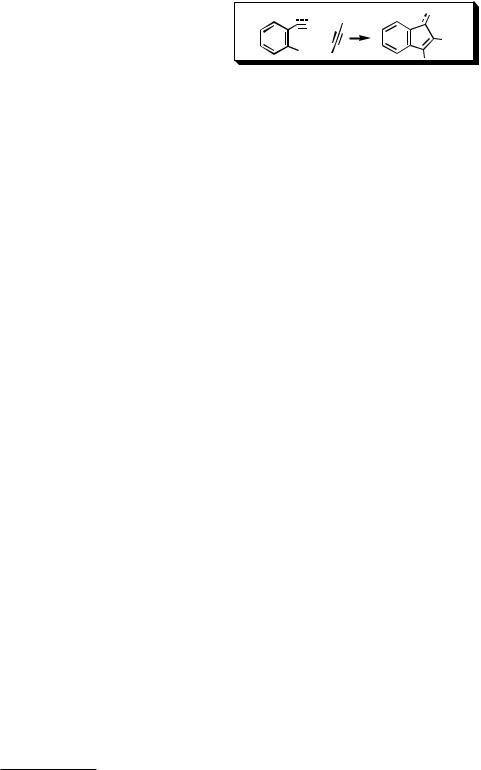
IV.2.6 Carbopalladation of Alkynes Followed by Trapping with Electrophiles
VLADIMIR GEVORGYAN and YOSHINORI YAMAMOTO
A. INTRODUCTION
In contrast to the diverse insertion chemistry of vinylpalladium intermediates discussed in Sects. IV.3 and IV.5, the reactions of vinylpalladium complexes with electrophiles had not been reported until recently. Although a single report on the annulation of the o-mer- curio benzaldehyde with diphenylacetylene into the corresponding indenols and indenones catalytic in palladium and stoichiometric in copper had been communicated in 1992,[1] the more synthetically useful protocol for the catalytic version of this type of transformation remained unknown until 1999. In this section the intermolecular carbopalladation of alkynes with aryl halides followed by the intramolecular trapping of the formed vinylpalladium species with ketones, aldehydes, and nitriles will be discussed.
B. CARBOPALLADATION OF ALKYNES FOLLOWED
BY TRAPPING WITH KETONES.
Palladium has been found to catalyze a nucleophilic cyclizing vinylpalladation of aryl ketones 1 with alkynes 2 to produce the indenols 3 in good yields (Scheme 1).[2] o-Bro- moacetophenone (1a) (1 equiv) reacted with 4-octyne (2g) (5 equiv) in the presence of Pd(OAc)2 (5 mol %) and KOAc (2 equiv) under an argon atmosphere in DMF (0.25 M) (Conditions A) at 100 °C to give the indenol 3ag in 82% isolated yield (Table 1, entry 1). Other palladium complexes, such as PdCl2(PPh3)2, Pd(PPh3)4, and Pd2(dba)3·CHCl3, also catalyzed this reaction; however, the yields of 3a in these cases were somewhat lower. When KOAc was replaced with NaOAc the reaction rate slowed down. Use of t- BuOK led to the total decomposition of ketone 1, and K2CO3 was found not to be effective as a base in this reaction at all. Diphenylacetylene (2c) readily reacted with 1a under the same conditions to produce the indenol 3ac in 63% yield (entry 2). After optimization of the reaction conditions the amount of alkyne 2 could be decreased to 1.5 equiv (versus 5 equiv for Conditions A) by adding either 10 mol% of PPh3 (Conditions B) or 10 equiv of EtOH (Conditions C) to the reaction mixture (Table 1). Thus, aryl alkyl ketones 1a,b reacted with alkyl-substituted alkynes 2h,g under Conditions C to give the indenols 3ah,bg in moderate yields (53% and 51%, respectively, entries 3 and 4). In
Handbook of Organopalladium Chemistry for Organic Synthesis, Edited by Ei-ichi Negishi ISBN 0-471-31506-0 © 2002 John Wiley & Sons, Inc.
1361
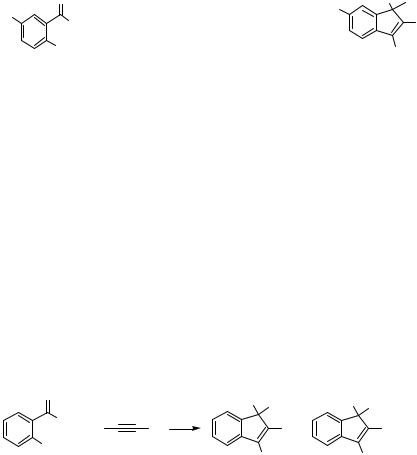
1362 |
IV Pd-CATALYZED REACTIONS INVOLVING CARBOPALLADATION |
|
|
|
|
||||||
TABLE 1. Cyclizing Vinylpalladation of Aromatic Ketones a |
|
|
|
|
|
||||||
Entry |
Ketone 1 |
|
Alkyne 2 |
Conditions b |
Temperature/ |
Products (%) c |
|||||
|
|
|
|
|
|
|
|
|
|
|
|
|
R1 |
|
R2 |
R3 |
|
Time (°C/h) |
3 |
4 |
|||
1 |
a Me |
g n-Pr |
n-Pr |
A |
100/20 |
|
ag 82 |
|
|||
2 |
a Me |
c Ph |
Ph |
A |
100/20 |
|
ac 63 |
|
|||
3 |
a Me |
h CH2OMe |
CH2OMe |
C |
100/20 |
|
ah 53 |
|
|||
4 |
b t-Bu |
g n-Pr |
n-Pr |
C |
100/24 |
|
bg 51 |
|
|||
5 |
c Ph |
g n-Pr |
n-Pr |
B |
100/96 |
|
cg 86 |
|
|||
6 |
c Ph |
c Ph |
Ph |
B |
120/24 |
|
cc 75 |
|
|||
7 |
c Ph |
h CH2OMe |
CH2OMe |
C |
100/28 |
|
ch 64 |
|
|||
8 |
c Ph |
i — (CH2)10 — |
B |
100/96 |
|
ci |
76 |
|
|||
9 |
d p-CF3C6H4 |
g n-Pr |
n-Pr |
B |
100/24 |
|
dg 85 |
|
|||
10 |
e p-MeOC6H4 |
g n-Pr |
n-Pr |
C |
100/48 |
|
eg 64 |
|
|||
11 |
c Ph |
j Me |
t-Bu |
C |
100/48 |
|
cj 72 |
— |
|||
12 |
a Me |
k Me |
Ph |
A |
100/15 |
|
ak 48 |
20 d |
|||
13 |
a Me |
l n-Bu |
C#CBu |
A |
100/15 |
|
al 67 e |
33 e |
|||
14 |
O |
g n-Pr |
n-Pr |
B |
80/24 O2N |
|
Ph |
OH |
|||
O2N |
|
|
|
|
|||||||
|
Ph |
|
|
|
|
|
|
|
n-Pr |
||
|
|
|
|
|
|
|
|
|
|||
|
Br |
|
|
|
|
|
|
|
n-Pr |
|
|
|
f |
|
|
|
|
|
|
|
fg 66 |
|
|
|
|
|
|
|
|
|
|
|
|
|
|
aIn a typical procedure after completion of the reaction under the conditions indicated in the table, the reaction
was quenched (H2O), the mixture extracted (Et2O-H2O), and the extract dried (Na2SO4) and concentrated. The product was purified by column chromatography (Silica gel, eluent: hexane-ethyl acetate).
bConditions A: see text. B: A mixture of the ketone 1 (1 mmol), alkyne 2 (1.5 mmol), KOAc (2 mmol),
Pd(OAc)2 (5 mol %), and PPh3 (10 mol %) in DMF (0.25M) was stirred under an Ar atmosphere. C: The same mixture as above plus EtOH (10 mmol) was stirred under the conditions indicated in the table.
cIsolated yield unless otherwise specified.
d4ak was contaminated with a small amount of 3ak.
eThe products 3al and 4al were isolated as an inseparable mixture in 75% combined yield. The ratios were determined by 1H NMR spectroscopy.
contrast to the alkyl-substituted ketones 1a,b, the diarylketone 1c, under Conditions B and C, smoothly reacted with 4-octyne (2g), diphenyl- (2c) and dimethoxymethylacetylene (2h), and cyclododecyne 2i producing the indenols 3cg,cc,ch,ci in 86%, 75%, 64%, and 76%, respectively (entries 5–8). Substituted diarylketones 1d ( p-CF3) and 1e ( p- MeO) easily underwent carbocyclization with 2g giving 3dg,eg in 85% and 64% yields (entries 9 and 10). Although the reaction of 1c with the unsymmetrical alkyne 2j with a bulky t-butyl substituent produced 3cj in 72% yield as a single regioisomer (entry 11), the reactions of 1a with phenylpropyne 2k and di-n-butylbutadiyne 2l were less regioselective;
O |
|
R1 |
R1 |
|
R1 + R2 |
|
OH |
OH |
|
R3 Pd |
R3 + |
R2 |
||
Br |
Base |
|
|
|
|
R2 |
R3 |
||
1 |
2 |
|||
3 |
4 |
Scheme 1

IV.2.6 CARBOPALLADATION OF ALKYNES: TRAPPING WITH ELECTROPHILES |
1363 |
the indenols 3ak and 3al with bulkier substituents to the hydroxyl group were contaminated with the minor regioisomeric products 4ak and 4al, respectively (entries 12 and 13). As expected, this reaction is limited to internal alkynes. Under the conditions employed, terminal alkynes did not undergo cyclovinylation of 1, but Sonogashira-type coupling. The nitro-substituted benzophenone 1f underwent the reaction with 2g to give 3fg in 66% isolated yield (entry 14). Surprisingly, the yields of the indenols 3 were found to be consistently higher with aryl bromides 1 than with the corresponding aryl iodides.
As far as the mechanism of the observed intramolecular vinylpalladation of ketones is concerned, the reaction obviously starts with an oxidative addition of the catalytically active palladium(0) species to the C—Br bond of 1 to give 5, which would arylpalladate the triple bond of 2[3]–[5] to form the vinylpalladium species 6. The intramolecular nucleophilic addition of the vinylpalladium moiety to the keto group of 6 would produce the indenyloxypalladium species 7. The added potassium acetate would transmetallate 7 to the potassium alkoxide 8, which upon subsequent protonolysis would give the reaction indenol 3 and would regenerate the catalyst (Scheme 2). Although a more detailed mechanistic study is needed, the proposed catalytic cycle quite reasonably explains the observed overall cyclovinylation of o-bromoaryl ketones with internal alkynes. Thus, the observed regioselectivity in the arylpalladation of unsymmetrical alkynes 2j–l with 5 (Table 1, entries 11–13) is in a good agreement with the known regiochemical trend for the carbopalladation of alkynes.[6] Furthermore, the order of reactivity of differently
substituted ketones [ p-CF3C6H4 (1d, t1/2 4 h) C6H5 (1c, t1/2 16 h) p-MeOC6H4 (1e, t1/2 120 h)] provides additional support for the nucleophilic character of the
observed transformation 6 : 7 (Scheme 2).[2]
O
2
R1
Pd X
1
5
R1 O
Pd(0) |
PdX |
R3
6 R2
|
Pd(II) |
|
|
|
|
|
R1 |
|
|
|
OPdX |
|
R1 |
|
R3 |
|
|
|
|
|
OK |
|
|
H+ |
KOAc |
7 |
R2 |
3 |
R3 |
|
|
8 |
R2 |
|
|
|
Scheme 2 |
|
|
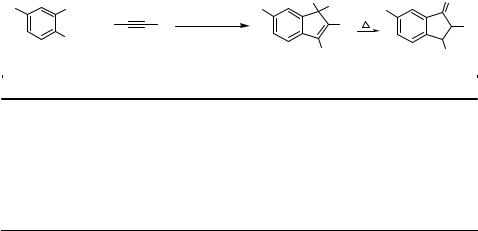
1364 |
IV Pd-CATALYZED REACTIONS INVOLVING CARBOPALLADATION |
C. CARBOPALLADATION OF ALKYNES FOLLOWED
BY TRAPPING WITH ALDEHYDES
Further development of the above-mentioned protocol led to the methodology for the synthesis of indenols 10 and indanones 11 through the catalytic intramolecular vinylpalladation of aromatic aldehydes 9 (Scheme 3).[7] Thus, o-bromobenzaldehyde (9a) (1 mmol) reacted at 60 °C with 4-octyne (2g) (1.5 mmol) in the presence of Pd(OAc)2 (5 mol %), KOAc (2 mmol), and EtOH (10 mmol) under an argon atmosphere in DMF (0.25 M) (Conditions D) to afford the indenol 10ag in 71% isolated yield (Scheme 3). The analogous reaction of 9a with cyclododecyne 2i gave indenol 10ai in 73% yield. Reaction of 9a with the unsymmetrical alkyne 2j afforded 10aj as a single regioisomer (Scheme 3). 5-Methoxy-2-bromobenzaldehyde (9b) also smoothly reacted with 2g under Conditions D to produce 10bg in reasonable yield.
R1 |
|
CHO |
|
R1 |
H |
OH |
R1 |
O |
|
|
|
|
|
||||||
|
|
|
+ R2 |
R3 |
Conditions D |
|
R3 |
R3 |
|
|
|
Br |
|
|
|
|
R2 |
|
11 R2 |
|
9 |
|
2 |
|
|
10 |
|
||
|
|
|
|
|
|
|
|
|
|
R1 |
|
R2 |
|
R3 |
Conditions |
10 (%) |
|
Conditions |
11 (%) |
a H |
g n-Pr |
n-Pr |
60 °C/12 h |
ag, 71 |
|
100 °C/24 h |
ag, 68 |
||
a |
H |
i |
(CH2)10 |
|
60 °C/12 h |
ai, 73 |
|
|
|
a |
H |
j Me |
|
t-Bu |
60 °C/12 h |
aj, 67 |
|
100 °C/36 h |
aj, 69 |
a H |
m Ph |
|
t-Bu |
60 °C/12 h |
am, |
|
|
am, 73 |
|
b OMe |
g n-Pr |
n-Pr |
60 °C/24 h |
bg, 58 |
|
|
|
||
Scheme 3
Surprisingly, when the reaction mixtures were stirred for longer times at 60 °C after the formation of indenols 10 had been complete, a considerable fraction isomerized to indanones 11. This transformation could be taken to completion by extended heating at more elevated temperature (100 °C). Thus, reaction of 9a with 2g under Conditions D for 12 h at 60 °C, followed by stirring for 24 h at 100 °C, produced indanone 11ag in 68% isolated yield (Scheme 3). The analogous treatment of 9a with 2j gave the indanone 11aj in 69% yield. Remarkably, the reaction of 9a with the aryl-substituted alkyne 2m, even under Conditions D, did not stop at the stage of the indenol 10am; instead the indanone 11am was formed in 73% yield. The isomerization of the indenols 10 into the indanones 11 was confirmed by a test experiment. Hence, stirring of 10ag at 100 °C in the presence of Pd(OAc)2 (5 mol %) and KOAc (2 equiv) for 24 h in DMF produced indanone 11ag quantitatively. Notably, this isomerization did not occur upon prolonged heating of 10ag at 100 °C in DMF in the absence of the palladium catalyst and the base.
Recently, Larock and co-workers reported an efficient method for the synthesis of indenones 13 by the Pd-catalyzed annulation of o-iodobenzaldehyde 12 with internal
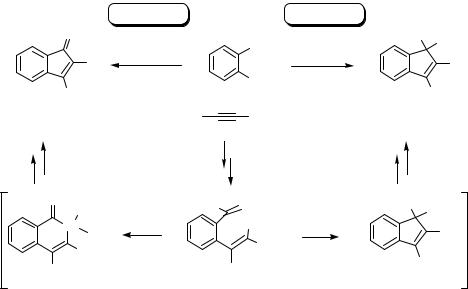
IV.2.6 CARBOPALLADATION OF ALKYNES: TRAPPING WITH ELECTROPHILES |
1365 |
alkynes 2 (Scheme 4).[8] This deserves some comments with regard to the mechanism of formation of indenols 10, in comparison with Larock’s mechanism for the formation of indenones 13 (Scheme 4). In the reaction of the o-iodobenzaldehyde with internal alkynes 2 in the presence of Pd(OAc)2 (5 mol %), NaOAc or Na2CO3 (4 equiv), and n- Bu4NCl (1 equiv) in DMF at 100 °C (Conditions E, Scheme 4), the indenones 13 were formed as the oxidative coupling or substitution products.[8] In contrast, o-bromoben- zaldehyde under Conditions D, produced the reductive coupling or nucleophilic addition products, the indenols 10 (Scheme 4).[7] Although the reaction modes look rather similar, it appears that these two transformations follow different mechanistic pathways. The vinylpalladium intermediate 14 may be formed through a Heck-type arylpalladation of the alkyne 2.[3]–[5] According to Larock et al.,[8] the vinylpalladium halide 14 then inserts into the C—H bond of the aldehyde group to form the Pd(IV) intermediate 15, which after subsequent dehydrohalogenation and reductive elimination reforms the Pd(0) species and gives the substitution product, indenone 13. A vinylpalladium halide of type 14 must also be an intermediate en route to the indenols 10 (Scheme 4, Conditions D). However, under Conditions D, rather than insertion into the C—H bond, a nucleophilic vinylpalladation of the C"O group of the aldehyde takes place to form the indenyloxypalladium species 16, which after subsequent transmetallation with KOAc and protonolysis gives the nucleophilic addition product, the indenol 10 (Scheme 4).[7]
O
R2
R1
13
O
H
Pd
I
R2
15 R1
Conditions E
10, Pd(OAc)2
DMF
X = I NaOAc n-Bu4NCl
Conditions D
|
CHO |
|
|
H |
OH |
|
|
|
|
||
|
10, Pd(OAc)2 |
|
|
|
|
|
|
|
|
2 |
|
|
|
|
|
|
R |
|
X |
DMF |
|
|
|
12 |
|
|
|
R1 |
|
+ |
|
10 |
|
||
|
|
|
|
|
|
R1 |
R2 |
|
|
|
|
2 |
|
|
|
|
|
H |
O |
|
|
H |
OPdBr |
|
|
|
|
|
|
|
PdX |
|
|
|
R2 |
|
R2 |
|
|
|
|
|
X = Br |
|
|
R1 |
|
14 |
1 |
KOAc |
16 |
|
|
R |
EtOH |
|
|
Scheme 4
An alternative explanation for the formation of indenols 10 would involve a transfer hydrogenation of a first formed indenone 13 with EtOH, present in the reaction mixture under conditions D, to give the indenols 10. This, however, could be ruled out, as the o-bromodeuteriobenzaldehyde [D1] – 9a under Conditions D gave [D1] – 10ag in 77% isolated yield with 99% of the deuterium label attached at the C-1 position (Scheme 5). Although the reasons for such a dramatic change in the reaction courses upon a slight modification in the conditions are not clearly understood, one may speculate the proposed
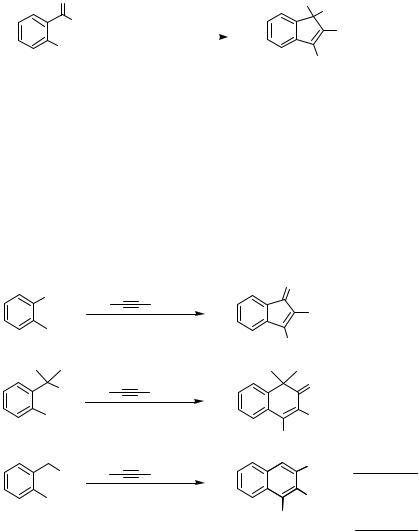
1366 |
IV Pd-CATALYZED REACTIONS INVOLVING CARBOPALLADATION |
palladium(IV) intermediate 15 would be stabilized in the presence of a quaternary ammonium salt in dipolar aprotic solvent (Jeffery conditions).[9] In fact, these conditions have previously been found to favor processes via Pd(IV) intermediates.[10] Under Conditions D, on the other hand, a direct nucleophilic addition of the vinylpalladium halide moiety of 14 to the aldehyde function apparently is more favorable, and this will drive a reaction toward the indenols 10 (Scheme 4).[7]
O |
|
D |
OH |
(99% D) |
(99% D) |
|
|||
|
|
|||
D |
2g, Conditions D |
|
n-Pr |
|
|
|
|||
Br |
77% |
n-Pr |
|
|
[D1]−9a |
|
|
||
|
[D1]−10ag |
|
|
|
Scheme 5
D. CARBOPALLADATION OF ALKYNES FOLLOWED
BY TRAPPING WITH NITRILES
Simultaneously with the report of Quan, Gevorgyan, and Yamamoto on the intramolecular nucleophilic vinylpalladation of ketones,[2] Larock, Tian, and Pletnev disclosed an intramolecular addition of vinylpalladiums to nitriles (Scheme 6).[11]
CN |
|
|
O |
|
|
|
Ph |
Ph , [F] |
|
|
|
|
|
|
Ph |
96% |
|
|
||
I |
|
|
|
|
||
|
|
|
|
|
|
|
17a |
|
18 |
Ph |
|
|
|
CN |
Ph |
Ph , [F] |
O |
|
|
|
|
67% |
|
|
|||
I |
|
|
|
|
|
|
|
|
Ph |
|
|
|
|
17b |
|
19 |
Ph |
|
|
|
CN |
R1 |
R2 , [G] |
NH2 |
R1 |
R2 |
% |
|
|
|
|
|||
I |
|
|
R2 |
Ph |
Ph |
83 |
|
|
Me |
Ph |
65 |
||
17c |
|
20 |
R1 |
|||
|
Me |
t-Bu |
75 |
|||
|
|
|
|
[F] = 10 mol % Pd(dba)2, 3 equiv of alkyne 1 equiv of Et3 N, DMF/H2O = 9:1, 130 °C, 24 h.
[G] = 5 mol % Pd(OAc) 2, 3 equiv of alkyne, 2 equiv of Et3N, 1 equiv of n-Bu4NCl, DMF, 100 °C, 48 h.
Scheme 6
IV.2.6 CARBOPALLADATION OF ALKYNES: TRAPPING WITH ELECTROPHILES |
1367 |
In the presence of Pd(dba)2 (10 mol %) and Et3N (1 equiv) in DMF/H2O at 130 °C, o-iodobenzonitrile 17a cocyclized with diphenylacetylene (3 equiv) to afford, after the subsequent hydrolysis, 2,3-diphenylindenone (18) in 96% yield (Scheme 6). An extention of this cocyclization methodology was demonstrated with the transformation of 2-o-iodophenyl-2-methylpropionitrile (17b), which gave the benzannulated ketone 19 in good yield (Scheme 6). Surprisingly, -naphthylamines 20 were obtained when the o-iodophenylacetonitrile (17c) was employed instead of 17b (Scheme 6). The reaction proceeded smoothly with symmetrical and unsymmetrical internal alkynes to give the-naphthylamines 20 in good yields (Scheme 6). It is assumed that in all cases an intramolecular vinylpalladation of the nitrile produces an iminyl palladium intermediate. However, in the latter cases, due to the presence of a hydrogen atom to an iminyl palladium moiety, a tautomerization occurs rather than hydrolysis.[11]
Cascade intermolecular carbopalladations of alkynes followed by intramolecular trapping with electrophiles represent not only a novel type of organic transformation involving vinylpalladium intermediates, but also provide synthetically useful routes toward differently substituted indenols,[2,7] indanones,[7] indenones,[8] and naphthylamines.[11] Although these protocols are restricted to the intramolecular trapping with electrophiles, a wide application of this methodology toward the synthesis of various types of complex carbocyclic compounds may be anticipated in the near future.
REFERENCES
[1]J. Vicente, J.-A. Abad, and J. Gil-Rubio, J. Organomet. Chem., 1992, 436, C9.
[2]L. G. Quan, V. Gevorgyan, and Y. Yamamoto, J. Am. Chem. Soc., 1999, 121, 3545.
[3]J. Tsuji, Palladium Reagents and Catalysts, Wiley, Chichester, 1995, 560 pp.
[4]E. Negishi, C. Copéret, S. Ma, S.-Y. Liou, and F. Liu, Chem. Rev., 1996, 96, 365–393.
[5]R. F. Heck, Acc. Chem. Res., 1979, 12, 146–151.
[6]R. C. Larock and Q. Tian, J. Org. Chem., 1998, 63, 2002.
[7]V. Gevorgyan, L. G. Quan, and Y. Yamamoto, Tetrahedron Lett., 1999, 40, 4089.
[8]R. C. Larock, M. J. Doty, and S. Cacchi, J. Org. Chem., 1993, 58, 4579.
[9]T. Jeffery, Tetrahedron Lett., 1985, 26, 2667.
[10]A. de Meijere and F. E. Meyer, Angew. Chem. Int. Ed. Engl., 1994, 33, 2379–2411.
[11]R. C. Larock, Q. Tian, and A. A. Pletnev, J. Am. Chem. Soc., 1999, 121, 3238.
